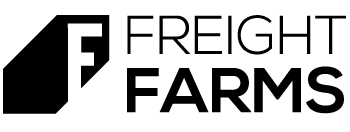K-12 Funding How To – Crowdfunding and Online Fundraising
Funding innovative projects like an on-site Freight Farm and sustainability program often requires creative financial solutions. Over the past few years, crowdfunding has become a powerful tool for schools, allowing them to extend their fundraising reach far beyond local community boundaries. This method diversifies funding sources and fosters a more robust community connection, rallying support from alums, parents, and global supporters.
Freight Farms, a pioneer in developing compact and efficient hydroponic farms, offers a unique opportunity for schools. By integrating Freight Farms' systems, schools can enhance their STEM curricula and promote hands-on learning in sustainability and agriculture. Through platforms like the ones discussed below, K-12 schools can secure the necessary funds to bring these innovative solutions to their students, providing invaluable educational experiences beyond traditional classroom settings.
Understanding Crowdfunding in Education
What is Crowdfunding?
Crowdfunding is raising capital through the collective effort of friends, family, customers, and individual investors. This approach taps into a large pool of individuals—primarily online via social media and crowdfunding platforms—and leverages their networks for greater reach and exposure.
Importance of Crowdfunding for Educational Institutions
In the context of education, crowdfunding is particularly significant. Schools often face budget constraints that limit their ability to implement new technologies or innovative programs. Crowdfunding enables educational institutions to bypass traditional funding limitations and directly engage with a community that is digitally savvy and ready to support meaningful projects.
Benefits of Online Fundraising for Schools
Broader Audience Reach: Online platforms allow schools to reach potential donors worldwide, significantly expanding their fundraising potential beyond local community events.
Engagement and Community Building: Crowdfunding campaigns provide a platform for schools to share their stories and engage with donors on a personal level, building a sense of community and shared purpose.
Efficiency and Accessibility: Digital tools allow schools to set up fundraising campaigns quickly and with minimal upfront costs. Online platforms also offer tools to track campaign progress, engage with backers, and disseminate updates, making the process transparent and accessible to all.
Incentivized Giving: Many platforms allow creative incentives, such as acknowledgments, merchandise, or experiences, to be offered in return for donations, which can increase participation and engagement.
Crowdfunding is not just a funding tool but also a powerful medium for storytelling. Schools can communicate their vision, mission, and the tangible benefits of their projects through this narrative, which is crucial in building emotional connections with potential donors and can significantly influence the success of a campaign.
Key Platforms for Educational Crowdfunding
When selecting a crowdfunding platform, schools should consider several factors, such as the platform’s focus, fee structure, ease of use, and success rate for educational projects. Here, we review several popular platforms that have been used effectively for school-related fundraising.
DonorsChoose
Overview: Founded in 2000, DonorsChoose is an American nonprofit organization that allows individuals to donate directly to public school classroom projects. This platform is specifically designed for educational purposes, making it an ideal choice for K-12 schools looking to fund specific projects or resources.
Pros:
Tailored specifically towards educational projects.
High visibility among educators and those interested in supporting schools.
Provides tax deductions to donors.
Cons:
Restricted to public schools in the United States.
Limited to funding specific classroom projects, not larger initiatives.
GoFundMe
Overview: GoFundMe is one of the largest crowdfunding platforms worldwide, known for its flexibility in fundraising for virtually any cause, including educational campaigns.
Pros:
Wide reach, accessible to a global audience.
Allows for a variety of educational fundraising, from small projects to large-scale initiatives.
User-friendly interface with robust social media integration for campaign promotion.
Cons:
Higher fees compared to some other platforms.
The broad focus might dilute attention from specifically educational donors.
Kickstarter
Overview: Kickstarter is a global crowdfunding platform that brings creative projects to life. Though not exclusively educational, schools can use it to fund projects that have a creative or innovative angle.
Pros:
Wide audience reach, suitable for innovative educational projects with a creative twist.
All-or-nothing funding encourages strong promotional strategies.
Cons:
Not specific to education, which might require more effort to attract suitable donors.
The project must reach its full funding goal, or no funds will be received.
Indiegogo
Overview: Indiegogo is a versatile crowdfunding platform that supports a variety of projects, including those in the educational sector. It offers both fixed and flexible funding options, allowing campaigners to keep the funds they raise even if the goal is not met.
Pros:
Campaigners can choose to keep all funds raised, even if the goal isn’t fully met.
Indiegogo has an extensive international user base, which can be particularly useful for schools looking to attract donations from a global community.
Supports a wide range of initiatives, from small-scale classroom enhancements to larger educational technology projects.
Cons:
Compared to platforms like DonorsChoose, Indiegogo does not specialize in educational projects, which might require more marketing and outreach effort to attract the right audience.
Due to its general nature, educational campaigns might compete against a wide variety of other projects for attention and funding.
Classy
Overview: Classy is a fundraising platform tailored specifically for nonprofits, making it ideal for educational institutions with 501(c)(3) status looking to launch comprehensive fundraising campaigns.
Pros:
Offers extensive tools for managing nonprofit fundraising campaigns, including event management, peer-to-peer fundraising, and donor management.
Provides excellent customer support and a wealth of resources to help schools plan and execute successful campaigns.
Cons:
Classy's advanced features come at a price, with subscription fees that may be prohibitive for smaller schools or those new to crowdfunding.
The wide array of features can be overwhelming, requiring more time and expertise to manage effectively.
Fundly
Overview: Fundly is known for its ease of use and visual appeal, allowing schools to set up visually engaging campaigns with minimal technical expertise.
Pros:
Schools can easily manage their campaigns with Fundly's intuitive dashboard and simple setup process.
Fundly does not charge a setup fee, making it accessible for schools new to crowdfunding or with limited upfront funds.
The platform is highly optimized for mobile devices, ensuring that campaigns are easily accessible on smartphones and tablets, which is crucial for reaching a broader audience.
Cons:
Unlike platforms like DonorsChoose, Fundly does not specifically target donors interested in educational projects, which may require additional campaign marketing efforts.
While it has no upfront costs, Fundly's fee structure includes a platform fee plus payment processing fees, which can add up.
Crowdfunding has revolutionized how educational projects receive funding, allowing schools to reach broad audiences and gather support from across the globe. Platforms like DonorsChoose, GoFundMe, Kickstarter, Indiegogo, Classy, and Fundly offer various features that cater to different needs, whether focused on creativity, flexibility, or non-profit support. Each platform has unique advantages and limitations, and choosing the right one depends heavily on the specific requirements and goals of the educational institution.
For schools looking to integrate innovative solutions like Freight Farms, crowdfunding not only offers the financial backing necessary but also builds a community of supporters who share in the success of educational advancements. The case studies highlighted in this blog demonstrate the powerful combination of innovative technology and community support, which can lead to sustainable educational programs that benefit students for years.
Best Practices for Schools Using Crowdfunding Platforms
Clear, Compelling Goals
Specificity in Objectives: Define exactly what the campaign aims to achieve. For example, if the goal is to introduce a Freight Farms system into your school, specify how it will be integrated into the curriculum, what the students will learn, and the anticipated outcomes of this integration.
Quantifiable Targets: Set and share specific funding targets that directly correlate with tangible outcomes, such as purchasing equipment, training teachers, or renovating spaces for the farm.
Visual Plans: Where possible, include architectural renderings, project timelines, and detailed budgets in your campaign description. This not only adds credibility but also helps donors visualize the impact of their contributions.
Engaging Storytelling
Multimedia Integration: Utilize a mix of videos, images, and graphics to make your campaign more engaging. For instance, a video tour of a current classroom, interviews with teachers who will lead the program, and visual simulations of planned projects can capture the interest of potential donors.
Emotional Appeal: Share stories from students, teachers, and community members highlighting the need and the expected changes the project will bring. Personal stories or testimonials can emotionally engage potential donors and motivate them to support your cause.
Social Proof: To build trust and credibility, showcase previous successful projects or endorsements from well-respected community figures or organizations.
Regular Updates
Progress Tracking: Regularly post updates on the campaign page to keep your backers informed about how close you are to reaching your financial goals. Celebrate milestones, such as reaching 25%, 50%, and 75% of your target.
Behind-the-Scenes Insights: Share photos, videos, or stories about the preparations being made in anticipation of reaching the funding goal. For instance, updates on staff training, students' preparation, or site preparations for the Freight Farms installation.
Interactive Engagement: Encourage donor interaction by responding to comments, questions, and messages. This will maintain interest and build a community around your project.
Transparency
Detailed Budget Breakdown: Provide a clear and detailed breakdown of all costs associated with the project. This could include the cost of the Freight Farm unit, installation fees, necessary supplies, training sessions, and other related expenses.
Accountability Measures: Outline how you plan to manage the funds, including any financial oversight or third-party audits that will ensure the funds are used appropriately.
Reporting Back: Commit to reporting how funds are spent once the project is underway or completed. This could be in the form of final reports, ongoing blog posts, or a series of newsletters that document the use of the funds and the project's outcomes.
Implementing these best practices will help you achieve your fundraising goals and build lasting trust and engagement with your donors. Effective crowdfunding is as much about fostering relationships with your supporters as it is about reaching financial targets, and these strategies are designed to do both. By clearly articulating your goals, engaging your audience with compelling narratives, maintaining transparency, and keeping everyone informed, your school can harness the power of crowdfunding to bring exciting educational projects to fruition.
Engaging the Community and Beyond
To further enhance the impact of your crowdfunding campaign, consider these additional strategies:
Community Involvement
Engage with local businesses, alumni, and parents by offering them an opportunity to participate in the campaign through matching gifts or sponsorship opportunities.
Social Media
Utilize social media platforms to create buzz around your campaign. Regular posts, live videos, and interactive content can keep your audience engaged and encourage shares and donations.
Events and Webinars
Organize events or webinars that showcase the benefits of the project you are fundraising for. This can provide a tangible connection between potential donors and the project, increasing the likelihood of contributions.
Alumni Outreach
Leverage the school alumni network by sharing success stories and updates that demonstrate the ongoing value of their alma mater, inspiring them to give back.
Final Thoughts
The journey of funding educational projects through crowdfunding is as much about building relationships as it is about achieving financial goals. By choosing the right platform and employing strategic practices, schools can create successful campaigns that fund their projects and enhance their educational programs and community engagement. With technologies like Freight Farms, schools are equipped to offer students cutting-edge learning experiences that prepare them for the challenges of the future in sustainable ways.
As we conclude, remember that the success of a crowdfunding campaign is directly tied to how well the story is told and how effectively the community is engaged. With the right approach, schools can achieve remarkable results, bringing innovative educational projects to life and making a lasting impact on their students and communities.










